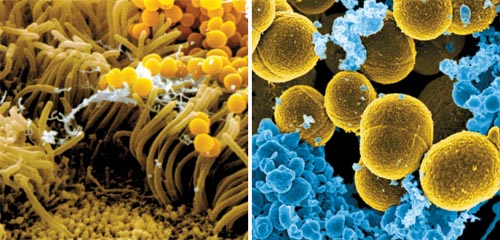Superbug hits Korea, infects two in hospital

Microscopic photographs of so-called “superbacteria.” [JoongAng Ilbo]
For the first time, Korea had two patients become infected with a bacterium called NDM-1 CRE, a so-called “superbacterium” for its resistance to most antibiotics.
The Ministry of Health and Welfare said yesterday that the two patients, a man in his 50s with lung disease and a woman in her 70s with diabetes, are being treated after curing them of the superbacterium infection.
Two other patients in the same hospital are also suspected of infection and are undergoing tests.
The ministry said neither patient had ever traveled abroad. They have been in the same hospital for a long time.
“Ordinary people don’t have much of a risk of being infected with a superbacterim,” the ministry said. “In most cases, the bacteria are transmitted when people have been hospitalized for a long time or their immune systems get significantly weakened.”
“Furthermore, we have two antibiotics that work against the bacteria, Colistin and Tigecycline,” the ministry said.
Doctors say symptoms of NDM-1 CRE are urinary tract infections and pneumonia. NDM-1 CRE has killed one person in Europe.
According to the ministry, the bacteria doesn’t cause any problems if they reside in the intestines, but if they reach the blood or organs, they create enzymes that hinder antibiotics’ efficacy.
To prevent more cases in hospitals, the Korea Centers for Disease Control and Prevention said yesterday that it will order 1,189 hospitals with at least 100 beds to launch emergency centers to prevent the bacterium infection. The center is investigating how the first two patients became infected.
Originally discovered in India in 2008, NDM-1 CRE has been found in 180 people worldwide. As of August, there were 70 confirmed cases in India, 73 in Pakistan and Bangladesh, and 37 cases in the United Kingdom. The only fatality was in Belgium.
“Most previous patients infected with NDM-1 CRE visited India or had surgeries in hospitals in India,” said Lee Yeong-seon, director of the Division of Antimicrobial Resistance at the Korea Centers for Disease Control and Prevention. The first patient in 2008 was a Swedish national infected during a surgery in New Delhi.”
Lee said if a carrier with NDM-1 CRE has a healthy immune system, he could show no symptoms and the bacteria could die off.
“After we saw the spread of the bacterium was fairly fast, we decided to list NDM-1 CRE on our epidemic list on Nov. 1,” Lee said.
Lee Eui-chong, a doctor in the Department of Laboratory Medicine at Seoul National University Hospital, warned that the two antibiotics don’t always work in combating the bacteria.
“Colistin, one of the medicines, has high toxicity, so if a person has low tolerance for the toxicity, doctors can’t use it,” the doctor said. “Tigecycline is sometimes unusable for different genes of the bacterium.”
“As there is no other way to fight the bacterium except the two antibiotics, the superbug is a serious matter for us,” Lee said. “It is highly important to block the virus from entering Korea as fast as possible.”
By Kim Hee-jin [heejin@joongang.co.kr]










with the Korea JoongAng Daily
To write comments, please log in to one of the accounts.
Standards Board Policy (0/250자)